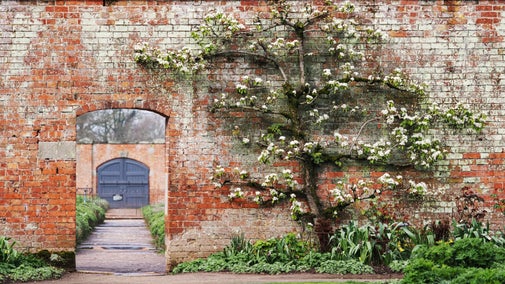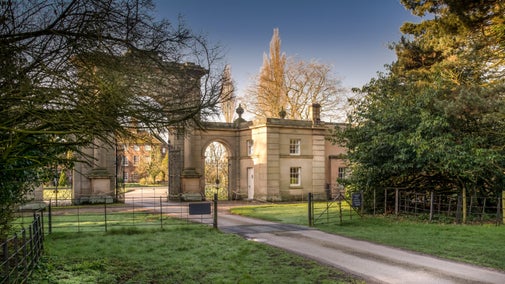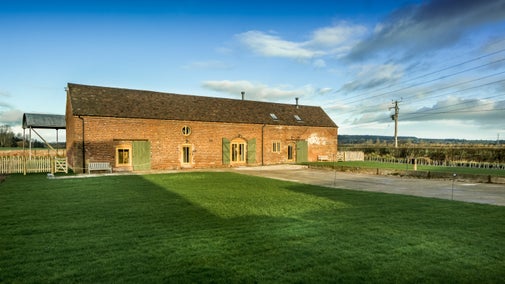
Join
Enjoy access to more than 500 places with National Trust membership. Join today and help protect nature, beauty and history – for everyone, for ever.
An 18th-century estate for all seasons with 200 acres of parkland and Regency Mansion
Atcham, Shrewsbury, Shropshire, SY4 4TP

| Asset | Opening time |
|---|---|
| Mansion ground floor | 11:00 - 16:00 |
| Mansion basement | 11:00 - 16:00 |
| Carriage House Café | 09:00 - 17:00 |
| Park | 08:00 - 18:30 |
| Playground | 08:00 - 18:30 |
| Shop | 10:00 - 17:00 |
| Walled garden | 09:00 - 17:00 |
On weekdays from Monday 19 February until Friday 22 March visits to 'above stairs' in the Mansion are by guided tour only. Please speak to Visitor Reception on arrival to book a tour ticket. On weekends during that time and daily from Saturday 23 March to Sunday 3 November visits 'above stair' are free-flow. The basement is open daily in the Mansion for free-flow visits.
| Ticket type | Gift aid | Standard |
|---|---|---|
| Adult | £17.60 | £16.00 |
| Child | £8.80 | £8.00 |
| Family | £44.00 | £40.00 |
| 1 adult, 3 children | £26.40 | £24.00 |
| Ticket type | Gift aid | Standard |
|---|---|---|
| Adult | £12.10 | £11.00 |
| Child | £6.10 | £5.50 |
| Family | £30.30 | £27.50 |
| 1 adult, 3 children | £18.20 | £16.50 |
Attingham has two 7kw Vend Electric vehicle charging points in the main car park to the left
Dogs must be on leads in all outdoor areas of the site at all times except for in the designated off-lead areas. Assistance dogs are welcome inside the café, shop and bookshop
Designated Blue Badge parking. Trampers/Wheelchairs (subject to availability) available to hire. Changing Place facility available with radar key (ask at Visitor Reception). Toilets at Stables, Brew House, Walled Garden and Field of Play.
Changing Place facility available with radar key (ask at Visitor Reception)
Trampers/Wheelchairs (subject to availability) can be pre-booked by calling Visitor Reception between 10am - 4pm on 01743 708118 no later than 4pm the day before their visit
Cobbles in the Stables Courtyard and Mansion access is via steps
On B4380, 4 miles south-east of Shrewsbury, follow brown directional signage to the main gates and on to one way access drive through front parkland. Please note there may be cattle grazing in the parkland and the site is closed at 6.30pm.
Parking: Designated parking available for blue badge holders.
Sat Nav: Please use postcode SY4 4TP and follow signs on approach.
Visitor Reception is ½ mile along park road from front entrance gates (main entrance). Please note there may be cattle grazing in the parkland. Site closed at 6.30pm.
Shrewsbury 5 miles
Shrewsbury to Telford
Please note there may be cattle grazing in the parkland. Site closed at 6.30pm.

Enjoy a walk around Attingham’s restored Walled Garden and discover the seasonal top things to spot in the kitchen garden, orchard and pleasure grounds.

Discover the surprising story of Attingham’s hidden home—a two-storey apartment in the East Wing of the Mansion.

Discover what family-friendly activities are on offer at Attingham Park this summer, from the Field of Play to parkland trails and things to see in the house.

There's a fabulous line-up of events taking place at Attingham this year, find out what's going on and when.
Georgian Mansion built to impress and commissioned in 1782 for Noel Hill, 1st Lord Berwick. Picture gallery was designed by John Nash. Also includes hidden home and wallpaper conservation studio tours.
Walled kitchen garden and orchard from around 1780s. Includes a bothy and glasshouses growing fruit, vegetables and flowers. National Collection of camassia flowers in May.
Shrub and tree landscaped area designed by Thomas Leggett between 1770-72. Includes Mile Walk, restoration of original planting plan is ongoing.
The Field of Play is a large natural play area, which includes some traditional play equipment and tunnel designed features.
Includes woodland, walk routes, deer park and a variety of wildlife, River Tern runs through the estate. Designated SSSI for saproxylic insects.
Established in the early 1800s by 2nd Lord Bewick. Home to the Attingham fallow deer, which are descendants of the original deer herd.
Carriage House Café serves drinks, cakes and bakes and lunches. Mansion Tea-room and Field of Play kiosk have limited opening times.
Stables Shop with wide range of gifts, homeware, local products and seasonal plant sales. Extensive second-hand bookshop.

See the estate spring to life in vibrant colours. Hyacinths, blossom trees, daffodils, bluebells and tulips will all be in bloom, alongside our national collection of camassias. Towards the end of May we’ll also see rhododendrons, laburnum and azaleas in colour.

Discover the surprising story of Attingham’s hidden home—a two-storey apartment in the East Wing of the Mansion.

There's a fabulous line-up of events taking place at Attingham this year, find out what's going on and when.

Enjoy a walk around Attingham’s restored Walled Garden and discover the seasonal top things to spot in the kitchen garden, orchard and pleasure grounds.

Uncover a changing story of love and neglect, of changing fortunes, revival and rediscovery inside the Regency Mansion at Attingham.

Discover nature and wildlife thriving on Attingham’s historic estate. From ancient trees and wildflowers to cattle and deer, there’s plenty to look out for.

On this short circular walk, learn more about the interesting trees in the historic Pleasure Grounds around the Mile Walk at Attingham Park, with views across the River Tern to the Deer Park.

Admire the changing colours of the landscape and skies reflected in the River Tern, and discover the history of the river and landscape along the way.

Watch out for a wide range of wildlife, including fallow deer, ducks, swans and otters on this circular walk in the beautiful parkland of this great estate.

Tasty food and drink on the go, or gifts to take home; find out about refreshments and shopping at Attingham.

A retreat in town for two, in the last remaining watchtower on Shrewsbury’s medieval walls.

A newly-converted barn on the Attingham Park Estate.

A neo-classical lodge at the grand entrance to Attingham Park

A converted brick and timber barn on the Attingham Park Estate
Discover the sighs and sounds of spring as you go an adventure with Scrap's Spotter Trail this Spring.
A sociable Nordic Walk using Nordic Walking poles whilst enjoying the beautiful grounds and parkland at Attingham.
A sociable, fitness walk using Nordic Walking poles whilst enjoying the beautiful grounds and parkland at Attingham.
Hone your photography skills and learn how photography can help improve your mental health.
Are you ready for a minibeast adventure at Attingham this may half term?
Featuring a 30 piece orchestra, soloists, DJ and dancers - performing some of the most loved dance tracks from the past 4 decades. With tracks from Fatboy Slim to Chemical brothers this night is going to be epic.
We are delighted to announce that The UK Proms Tour will be coming to the stunning Attingham Park near Shrewsbury on the longest night of 2024.
Join Lindsey for a 2 hour photography workshop around the beautiful landscape of Attingham's parkland and discover what you can capture with your camera.
Attingham inspires a sense of beauty, space and awe. The imposing entrance, glimpses of the vast mansion against silhouettes of cedars and expansive parkland, epitomise classical design and Italian influence. Its completeness of survival exemplifies the rise and decline, love and neglect of great country-house estates. Discovering the Berwicks' estate with acres of parkland, miles of walks, the huge organic walled garden, large playfield and welcoming mansion is a full day out. There’s so much to see and do at Attingham, whether you’re a family looking for activities, both inside and out, or simply in search of a traditional visit to a historic house and parkland. Full of life and locally loved, there’s something for everyone all year round.

Work is beginning to make Attingham's glasshouses a safer, more accessible space for all. This work will both improve the appearance of the Walled Garden and provide a practical workspace for our gardeners to grow lots of fresh produce.

Attingham’s Deer Park was created in 1798 as part of Thomas, 2nd Lord Berwick’s grand improvements to the Mansion and grounds. The deer have held a special place in Attingham's heart ever since. Following on from Thomas, the deer herd are now carefully managed by the National Trust.

From ancient landscapes to mansion restoration, discover the rich history of the Attingham Estate.

Discover the ground-breaking conservation work breathing new life into the historic house at Attingham Park.

Discover how Attingham's outdoor teams maintain and conserve the 1,500 hectares of estate and parkland for visitors.
Discover more about our plans for nature recovery on the Attingham Estate; our partners, projects, planting and ways we're helping nature.

Attingham is full of life and locally-loved, with over 97 per cent of visitors within a 60 minute drive time of the estate, and many of those visiting regularly throughout the year.

Explore the magnificent collection at Attingham and its wide range of historic items, conjuring up the impression of a great house of the past, like ghosts inhabiting the mansion’s grand interiors.

Join the volunteers doing vital work at Attingham Park to maintain the mansion, parkland and gardens.

Enjoy access to more than 500 places with National Trust membership. Join today and help protect nature, beauty and history – for everyone, for ever.